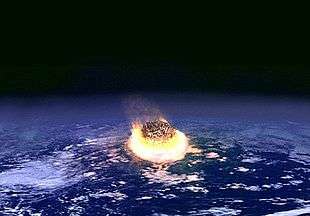1930 Curuçá River event
Coordinates: 5°1′S 71°38′W / 5.017°S 71.633°W
The 1930 Curuçá River event was a meteoric air burst that occurred on 13 August 1930 over the area of Curuçá River in Brazil.[1][2] It is based on the account of a single investigator who interviewed witnesses to the purported event, who then wrote a letter to the Vatican Observatory.
Overview
The event received little attention until 1995, when British astronomer Mark E. Bailey found in the Vatican Library archives a 1931 issue of L'Osservatore Romano, which contained a dispatch from the Franciscan monk Fedele d'Alviano. D'Alviano had visited the region five days after the event and interviewed people from the region; they told him they were frightened of what had happened. According to Bailey, the Curuçá event was one of the most important impact events of the 20th century.
Inspired by Bailey's article and based on images from Landsat satellites, the Brazilian astrophysicist Ramiro de la Reza was able to identify a potential astrobleme—the remains of a meteorite impact crater—measuring 1 km in diameter, to the southeast of the village of Argemiro.[2]
In the first week of June 1997, de la Reza led an expedition organized by Rede Globo and co-financed by ABC Television of Australia, to the region where the event occurred. A raised circular feature was found, but evidence is still lacking attesting that it came from a meteor impact. A record from the seismological observatory of San Calixto in La Paz indicated that the crater may have been created on the same date.[1] However, the earthquake that was recorded was smaller than what would be expected from the formation of a crater that size (a seismic signal that would have been detected by stations all over the world) and the signal was more consistent with a local event near the seismograph.[3][4]
The initial mass of the meteor has been estimated at between 1,000 and 25,000 tons.[5] Estimates for the energy released have varied from 9 kilotons,[3] 100 kilotons,[5] and 5 megatons,[1] though most estimates place the energy at below 1 megaton.[5][3][6] Regardless, the event was significantly smaller than the 10–15 megaton Tunguska event.
See also
References
- 1 2 3 Reza, Ramiro de la. O evento do Curuçá: bólidos caem no Amazonas (The Curuçá Event: Bolides Fall in the Amazon) (in Portuguese), Rio de Janeiro: National Observatory. Retrieved from the Universidade Estadual de Campinas website.
- 1 2 Reza, Ramiro de la; Martini, P. R.; Brichta, A.; Lins de Barros, H.; Serra, P.R.M. The Event Near The Curuçá River, presented at Rio de Janeiro, Brazil: 67th Annual Meteoritical Society Meeting, August 2–6, 2004. Retrieved from Universities Space Research Association (USRA) website, Columbia, MD.
- 1 2 3 Corderoa, Guadalupe; Poveda, Arcadio (2011). "Curuça 1930: A probable mini-Tunguska?". Planetary and Space Science. 59 (1): 10–16. Bibcode:2011P&SS...59...10C. doi:10.1016/j.pss.2010.10.012.
- ↑ http://citeseerx.ist.psu.edu/viewdoc/download?doi=10.1.1.177.2473&rep=rep1&type=pdf#page=160
- 1 2 3 McFarland, John. The Day the Earth Trembled Archived 2013-12-02 at the Wayback Machine., Armagh, Northern Ireland: Armagh Observatory website, last revised on November 10, 2009.
- ↑ Lienhard, John H. , The Engines of Our Ingenuity, University of Houston with KUHF-FM Houston.
Further reading
- http://alias.estadao.com.br/noticias/geral,estrondo--na-selva,1760865
- Bailey, Mark E. et al. 1995. The Observatory Vol. 115 (1128), pp. 250–253
- Daily Herald. Menace of meteors like huge bombs from space. 6 Mar 1931, p. 9.
- De la Reza, J. R.; Rumble in the Jungle, Quantum programme of the ABC-TV, Australia, directed by Richard Smith, ABC-TV Science Unit, 1998.
- Gehrels, T.,;Collisions with Comets and Asteroids. Scientific American, Vol. 274, No. 3., March, 1996, pp. 54–59.
- Gorelli, R.; The Rio Curuçá Event. Meteorite!, August 1995, p. 26.
- Huyghe, P.; Incident at Curuça. The Sciences, March/April, 1996, pp. 14–17.
- Informazioni Fides, L'Osservatore Romano. The Fall of Three Bolides on the Amazonas. Strange and Frightening Phenomena. 1 March, p. 5, 1931. (English translation in Bailey et al. 1995.)
- Kulik, L. A.; The Brazilian twin of the Tunguska meteorite. Priroda i Ljudi, 13-14, p. 6, 1931.
- Vasilyev, N.; and Andreev, G.; The Brazilian Twin of the Tunguska Meteorite: Myth or Reality? WGN, The Journal of the International Meteor Organization, 17, No.6, pp. 247–248, 1989.
- Vega, A. J.; Possible Evidencia Sismica del Evento "Tunguska" del 13 de Agosto de 1930, Ocurrido en Brasil. Revista Geofisica Instituto Panamericano de Geografia e Historia 44, Enero-Junio, pp. 201–211, 1996.
